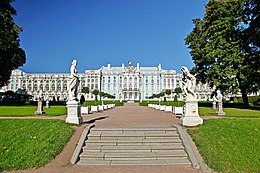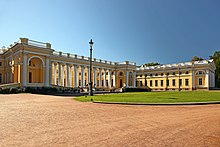|
Tsarskoye Selo
 Tsarskoye Selo (Russian: Ца́рское Село́, IPA: [ˈtsarskəje sʲɪˈlo] ⓘ, lit. 'Tsar's Village') was the town containing a former residence of the Russian imperial family and visiting nobility, located 24 kilometers (15 mi) south from the center of Saint Petersburg.[1] The residence now forms part of the town of Pushkin. Tsarskoye Selo forms one of the World Heritage Site Saint Petersburg and Related Groups of Monuments. The town bore the name Tsarskoye Selo until 1918. The new Bolshevik government of Soviet Russia renamed it as Detskoye Selo (Russian: Детское Село, lit. 'Children's Village'), which it held from 1918–1937. At that time, it was renamed under Stalin's government as Pushkin (Russian: Пушкин) after the famous Russian poet and writer. It is still known by that name. History The area of Tsarskoye Selo, once part of Swedish Ingria, first became a Russian royal/imperial residence in the early 18th century as an estate of the Empress-consort Catherine (later Empress-regnant as Catherine I, r. 1725–1727), for whom the Catherine Palace is named.[citation needed] When Peter the Great took possession of the mouth of the Neva, a Finnish village, Saari-mois, stood on the site now occupied by the town, and its Russified name Sarskaya was changed into Tsarskoye when Peter presented it to his wife Catherine. It was especially embellished by the tsaritsa Elizabeth. Under Catherine II., a town, Sophia, was built close by, but its inhabitants were transferred to Tsarskoye Selo under Alexander I. The railway connecting the town with St Petersburg was the first (1838) to be constructed in Russia.[2] The Alexander Palace (built from 1792 onwards) was first the home of Catherine the Great's grandson, the Grand Duke Alexander Pavlovich, who later became Emperor Alexander I (r. 1801–1825). After his abdication, Nicholas II and his family were held there by revolutionary forces under house arrest until 13 August 1917.[3] People built homes in the town where they also came to live when the court was in the country. The Royal Forestry School, perhaps the first such school in Russia, was founded in Tsarskoye Selo in 1803. It was moved to Saint Petersburg in 1811 and developed as the Imperial Forestry Institute.[4] According to historian Robert K. Massie,
Nickname for elite Soviet neighborhoodsIn the decades of the Soviet Union, people applied the nickname "the Tsar's village" to the blocks and small neighborhoods in major cities that housed the nomenklatura (Soviet elites). Their stores were better stocked, although they were still affected by Soviet-era shortages. The buildings in the neighborhoods were better designed, constructed and maintained.[5] For instance, one such neighborhood, west of Moscow, contained less industry and more parks than any other neighborhood.[6] Monuments
Gallery
See also
References
Further reading
External linksWikimedia Commons has media related to Tsarskoe Selo.
|
















